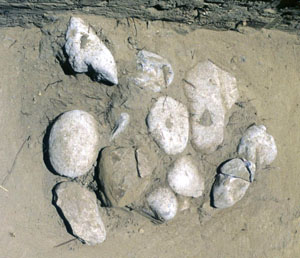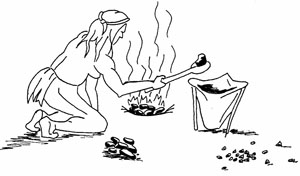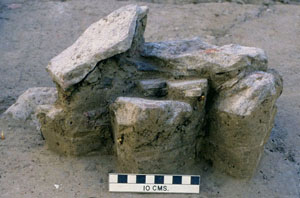Laredo Rio Grande
Recent excavations at three prehistoric sites south of Laredo near the Rio Grande provide a good look at the archeological record of the area and of the considerable challenges facing archeologists.The Lino site, the Boiler site, and the Becerra Creek site are all three open campsites set on relatively high terrain not far west of the Rio Grande. The Lino site is less than a mile from the river and is within the low valley of a small, intermittent creek that drains the surrounding uplands. The Becerra and Boiler sites are near one another about five miles from the river. Becerra occupies a gently sloping terrain leading from another wet-weather creek to the nearby uplands. Boiler is on a low hilltop upon the uplands proper. All three sites have Middle/Late Archaic components, the Lino site dating primarily to that period. The other two sites also have components dating the Late Prehistoric and Proto-Historic periods as well.
The Lino site (41WB437) and the Boiler site (41WB557) were investigated by TRC Mariah, an Austin-based environmental and archeological consulting firm; J. Michael Quigg was the lead archeologist at both sites. The work at the Becerra Creek site (41WB556) was carried out by the Center for Archaeological Research at the University of Texas at San Antonio; the lead archeologist was Richard B. Mahoney. The research at all three sites was undertaken as a result of highway expansion projects carried out the Texas Department of Transportation, who sponsored the investigations to satisfy federal and state laws.
All three sites had buried deposits with seemingly intact cultural features primarily consisting of clusters of burned sandstone rocks thought to represent cooking features. All three sites yielded stone tools and tool-making debris. Organic preservation of prehistoric-aged material was poor at these sites and consists of small quantities of charcoal, land snails, and a few mussel shell fragments. Some animal bones were recovered from Boiler and Becerra, but most appeared to be relatively recent in age. Of the three sites, only the Lino site was found to have reasonably well stratified deposits. It was found to have five or six occupation zones, each yielding relatively few stone tools. The other two sites lacked reasonably discrete occupation zones, although older materials were generally found deeper than younger materials.
Overall, the Laredo Rio Grande sites are characterized by poor organic preservation, evidence of stratigraphic mixing (particularly of smaller materials), and the lack of clear-cut changes in stone tool forms through time. Unstemmed triangular projectile points (especially of the Tortugas and Refugio styles) were the most common “diagnostic” artifact forms found at all three sites. The investigators also found dart points classifiable as Tortugas and Matamoros together. Collectively, these sites are primary examples of the prevalence of the unstemmed point tradition in the South Texas Plains and of the difficulty in meaningfully sorting out types in time. See Unstemmed Point Tradition and and Stone Tool Recycling.
During the analysis phase of each of the investigations, the researchers struggled with the difficulty of dating the deposits and of extracting good subsistence information—the foods consumed at these sites. Lacking much animal bone or charred plant remains, the researchers turned to the one type of artifact associated with food-preparation that was present in considerable numbers at all three sites: “burned” or “fire-cracked” pieces of sandstone. Cooked-stone technology was widely used throughout most of North America and has been well documented in many regions of Texas.
As mentioned, the sites all had intact clusters of burned sandstone that clearly represented cooking features of various sorts, including hearths, a few small earth/rock ovens, and simple dumps thought to represent stone-boiling discard piles. The locally available cook-stone material is sandstone, a relatively porous sedimentary rock composed of compacted sand held together by silica. (See the Rock Gallery in the Nature's Harvest exhibit.) Upon heating, sandstone rocks often become discolored by carbon-staining. They also absorb visually undetectable organic residues from both the firewood and from the food materials they were used to cook. Knowing or suspecting this, Mike Quigg and his colleagues pioneered the application of three new analytical techniques to the analysis of organic compounds extracted from burned pieces of sandstone from intact features.
Lipid Residue analysis involves extracting the microscopic organic compounds called lipids (insoluble fats, oils, and wax compounds) and identifying the fatty acid component by comparison to modern samples from different kinds of plants and animals. Most of the plants and animals can only be identified by class, such as large herbivores and deer/antelope. The site setting, however, limits the possibilities. In the South Texas Plains, the only large herbivore present in Archaic and Late Prehistoric times was the bison.
Stable Isotope analysis involves identifying the isotopic forms of carbon and nitrogen present in bones or, in this case, organic residues extracted from pieces of sandstone. This approach helps pin down the plant remains as different groups of plants follow different photosynthetic pathways.
The final approach, Residue Dating, involves extracting organic residues trapped in burned rocks for radiocarbon dating using the AMS method. The prospect of being able to directly date the rocks making up a cooking feature is exciting, because charred plant remains (such as charcoal or charred seeds) are often poorly preserved at many sites in the South Texas Plains.
All three of these analytic approaches are complex. As applied to organic residues extracted from burned rocks, the techniques are not yet well developed. Some archeologists are very skeptical that consistent results can be obtained from these methods, yet, almost all scientific techniques are developed in the face of skepticism. Collectively, the results from the application of these methods at the three Laredo Rio Grande sites show both the promise and the challenge. It is not possible to do justice to the complex results in a brief categorization. Learn more by reading Quigg’s 2003 article, linked below.
In summary, the prehistoric records of three Laredo Rio Grande sites, Lino, Becerra Creek, and Boiler, appear to have been created by small groups of native peoples following traditional hunting and gathering methods. The “sites” can perhaps be better thought of as geographically defined segments of the prehistoric landscape, rather than discrete campsites. Prehistoric peoples frequented the higher terrain on the east side of the Rio Grande following game and available plant resources. The archeological investigations of all three sites demonstrate the challenges involved in developing more specific understandings of prehistoric life in the region.
Sources
Mahoney, Richard B., Raymond P. Mauldin, and Steve A. Tomka
2002 Archeological Data Recovery Excavations along Becerra Creek (41WB556), Webb County, Texas. Center
for Archaeological Research, Archaeological Survey Report 321, University of Texas at San Antonio.
Texas Department of Transportation, Environmental Affairs Division, Archeological Studies Program, Report
44.
Quigg, J. Michael
2003 New Analytical Approaches to South Texas Cultural Assemblages, La Tierra 30(3-4):15-23.
Download Article 
Quigg, J. Michael, Shane Pritchard, and Grant Smith
2002 The Boiler Site (41WB557): Utilization of an Upland Setting over the last 4200 Years, Webb
County, Texas. TRC Technical Reports 27277. Texas Department of Transportation, Environmental Affairs
Division, Archeological Studies Program, Report 45.
Quigg, J. Michael, Chris Lintz, Grant Smith, and Scott Wilcox
2000 The Lino Site: A Stratified Late Archaic Campsite in a Terrace of the San Idelfonzo Creek, Webb
County, Southern Texas. TRC Technical Reports 23756. Texas Department of Transportation, Environmental
Affairs Division, Archeological Studies Program, Report 20.
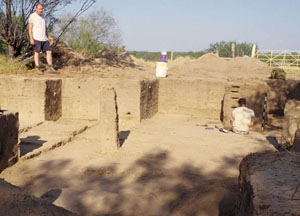
|
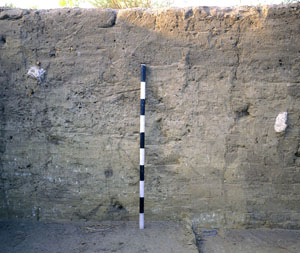
|
